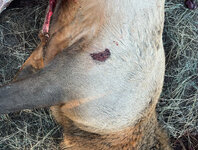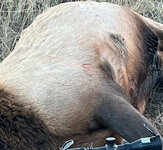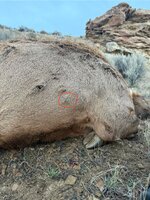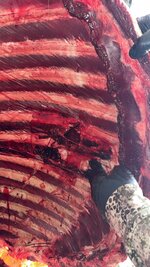I don't consider whollup to be compared to knocking an animal down necessarily. Adequate whollup means a wide wound channel, easily breaking all bones it it's way and leaving a 1 1/2" to 3" exit hole that sucks innards and blood out the other side.Are we using "Whollup" in place of mechanical kinetic energy transfer? If so ya its real and exists AKA physics... But it still does not tell you how a bullet will perform or correlate to wound channel. I cant remember off the top of my head but I believe it was Dr. Fackler that did research on this using metal or lead disks.. Also there is a paper in the link provided. The fact that "whollup" is "knockin em off their feet" just isn't true...

On the physics of momentum in ballistics: can the human body be displaced or knocked down by a small arms projectile? - PubMed
Shooting incidents are often portrayed as resulting in a sometimes violent backwards displacement of the victim. This opinion is also not infrequently held by expert witnesses. The physical force responsible for this would be momentum (mass x velocity). The physics of momentum in ballistic...pubmed.ncbi.nlm.nih.gov
Navigation
Install the app
How to install the app on iOS
Follow along with the video below to see how to install our site as a web app on your home screen.
Note: This feature may not be available in some browsers.
More options
Style variation
You are using an out of date browser. It may not display this or other websites correctly.
You should upgrade or use an alternative browser.
You should upgrade or use an alternative browser.
I think "Wallop" is a thing
- Thread starter doc holiday13
- Start date
- Joined
- Aug 25, 2020
- Messages
- 517
Again this is bullet dependant. For EXTREME example only lets say we have a .224 and .50 cal BMG both constructed like a heavy for caliber thin jacketed cup and core bullet IE TMK. both impacting at the same velocity in identical tissue/matter/animal. Yes by nature the 50 cal has more jacket to fragment and more lead core do drive the projectile deeper. But why? The .224 will most likely be caught and fully fragmented or "done" by the time it hits the off side of say a mule deer.. The 50 will still be going for say 10 mule deer deep. (I really don't know how many deer a 50 will penetrate) But what is the advantage? So you put a football size permanent wound channel in 1 deer vs a buick sized wound channel in 1 deer plus how ever many more. Furthermore the .224 will have realized its full potential inside 1 deer but the .50 will have never realized its full potential and at said hypothetical velocity may not have even began to fragment in the first 3/4 of the deers body. So I agree the heavy for caliber fragmenting bullets are way way more destructive than their lighter counterparts. But it begs the questions how much is too much? What am I gaining? Do I want the permanent wound channel to be fully inside the animal or just blow the back half out? So we find the happy medium. I want the Nalgene sized wound channel fully contained inside the animal, delivered from the lightest recoiling rifle it can, and effective out to what I deem MY range is.. I also have seen a photo from a big 30 that was using a heavy for caliber fragmenting match bullet on a deer. It was almost literally blown in half. A little hide below the spine and some belly is all that was left. Thoughts?I don't consider whollup to be compared to knocking an animal down necessarily. Adequate whollup means a wide wound channel, easily breaking all bones it it's way and leaving a 1 1/2" to 3" exit hole that sucks innards and blood out the other side.
EDIT. Now if we are comparing a solid copper mono to a solid copper mono that is just a matter of do you want a knitting needle sized hole or #2 pencil sized hole...
I really don't see any difference at all between my 6.5 Creedmoor and the .338 Win Mag I owned for two decades in terms of exits. Both seem to exit just fine.Yes, this is what was lost in the "kill everything with a .223" (i got one by the way) convo. I like my bullets to exit. I just do. I think it makes for better blood trails, and I think that matters. that doesn't make the .223 less deadly, it just means it will often not meet a criteria that I HAVE. Medium construction bullets that expand and still fully penetrate do a lot of both. I prefer that. I like a good .243 interlock in 100 gr.
However, man do larger calibers destroy a lot of meat on a deer. It can be gruesome. This last year I swore I was done hitting whitetails with a 3006.
However, it often felt as if the butt of that .338 Win Mag often exited my shoulder after pulling the trigger.
Chris in TN
WKR
- Joined
- Jun 17, 2025
- Messages
- 812
The problem with exit wounds - and I say this as someone who has preferred them for decades - is that quite often the heavier bullets that hedge your bets towards getting an exit, also push you towards *small* exits.I really don't see any difference at all between my 6.5 Creedmoor and the .338 Win Mag I owned for two decades in terms of exits. Both seem to exit just fine.
However, it often felt as if the butt of that .338 Win Mag often exited my shoulder after pulling the trigger.
In 2001 I lost a deer on a quartering away shot. I second guessed myself for two months, then we found the buck's head maybe 100 yards from where I'd shot him. He'd just went into a nasty pine thicket and without a blood trail (because I had no exit wound on the steep quartering away shot) there was no way to find him. We just chanced across his head on a rabbit hunt that winter. We'd repeatedly walked within a few feet of him the night I shot him - but in a thicket where 30' might as well have been half a mile.
(To be clear, that was a 30-06 on a 175 pound whitetail - plenty of 'wallop')
That pushed me to heavier bullets, for a number of years. But I began to notice that a lot of those still didn't exit on steep shots, and even when they exited, the wounds weren't always very big.
Probably the last straw in this regard, for me, was the elk I shot a couple years ago:
This is what a 0.284" 160 grain Nosler Accubond looks like when you make a pinwheel-perfect textbook shot on an elk at an impact speed of right at 2300'.
Entrance:

And the exit. It's the little red sideways 'v' spot on its hide:

That's about as perfect as shot placement gets. (451 yards, no wind). There was good internal damage to both lungs and the plumbing at the top of the heart was severely damaged. He ran maybe 75 yards. But what good was the exit wound? That sort of exit won't bleed enough to enable trailing an elk.
You could argue that the same bullet at 2500' or 2700' impact speed, might have left a larger exit. Or maybe a shoulder exit with some bone fragments might have left a better exit. But so what? Most critters with shoulder exits aren't going more than a few yards.
I shoot a lot of deer with smokeless muzzleloaders. Could have shot more than one, yesterday. But I generally use light to moderate loads, by smokeless standards. My 'heavy' load is a .40/225 at 2550'ish. Which is practically a freight train in terms of what it does to deer.I also have seen a photo from a big 30 that was using a heavy for caliber fragmenting match bullet on a deer. It was almost literally blown in half. A little hide below the spine and some belly is all that was left. Thoughts?
But I have seen videos of guys killing deer with .45 caliber 300+ grain projectiles at 2700' to 3000' and it honestly sort of bothers me to even watch. Exit wounds the size of small watermelons, at time. There's just no point in that, IMO.
Coleredding00
FNG
- Joined
- Jun 1, 2024
- Messages
- 96
A friend and i had this conversation after loading his cow elk he’d killed with his 6 creed. I got it on video through the spotter, and we were watching it over and over trying to see exactly where it had hit her. There was next to no indication that she had been hit all all short of the thwack and the fact she tipped over dead.
She made it all of 10 yards before expiring, textbook double lung quartering away shot, 336 yards, leaving what was rest of the slug at the joint of the scapula to the leg bone. Hard to make one any more dead. But you can definitely tell that the “wallop” everyone talks about was less than videos you see of the super duper loudenboomer magnums. The consensus we came to, is that using a similarly constructed bullet from a 300 PRC would absolutely deliver more energy into the animal, but to what end? Short of shocking the CNS into a bang flop, anything beyond what was done to this cow is unnecessary in my eyes

She made it all of 10 yards before expiring, textbook double lung quartering away shot, 336 yards, leaving what was rest of the slug at the joint of the scapula to the leg bone. Hard to make one any more dead. But you can definitely tell that the “wallop” everyone talks about was less than videos you see of the super duper loudenboomer magnums. The consensus we came to, is that using a similarly constructed bullet from a 300 PRC would absolutely deliver more energy into the animal, but to what end? Short of shocking the CNS into a bang flop, anything beyond what was done to this cow is unnecessary in my eyes


HilltopHitman
Lil-Rokslider
Hard to beat a 215 grain Berger!!!
A friend and i had this conversation after loading his cow elk he’d killed with his 6 creed. I got it on video through the spotter, and we were watching it over and over trying to see exactly where it had hit her. There was next to no indication that she had been hit all all short of the thwack and the fact she tipped over dead.
She made it all of 10 yards before expiring, textbook double lung quartering away shot, 336 yards, leaving what was rest of the slug at the joint of the scapula to the leg bone. Hard to make one any more dead. But you can definitely tell that the “wallop” everyone talks about was less than videos you see of the super duper loudenboomer magnums. The consensus we came to, is that using a similarly constructed bullet from a 300 PRC would absolutely deliver more energy into the animal, but to what end? Short of shocking the CNS into a bang flop, anything beyond what was done to this cow is unnecessary in my eyes View attachment 975673View attachment 975674
I took a spotting scope video of a buck being center punched with a 215 Berger out of a 300 RUM just 2 weeks ago, after a follow up shot to the brisket the buck still made a 300 yard death run before tumbling to the bottom of a draw. Another buddy of mine has shot 15-20 deer/elk with his 6.5 PRC and 147 ELD-M's, and hasn't had one go further than 50 yards post impact.Hard to beat a 215 grain Berger!!!
Similar threads
- Replies
- 27
- Views
- 3K
Featured Video
Latest Articles
- TT#64 Josh Boyd Elk Hunting Strategies for Every Season
- Aaron Davidson of Gunwerks
- TT#63 Dirk Durham’s Art of Elk Calling
- BIG Buck Stories with the Dirty Giants Podcast
- TT#62 Brian Barney Hunting Bulls without Calling
- Hoyt Alpha AX-2 SD Review
- Kuiu Kenai vs Outdoor Vitals Vario Hooded Jacket Review
- Hoyt RX-9 Ultra Review
- Hunting Vampire Bucks & Building an Optics Kit
- Darton Sequel ST2 35 Review
